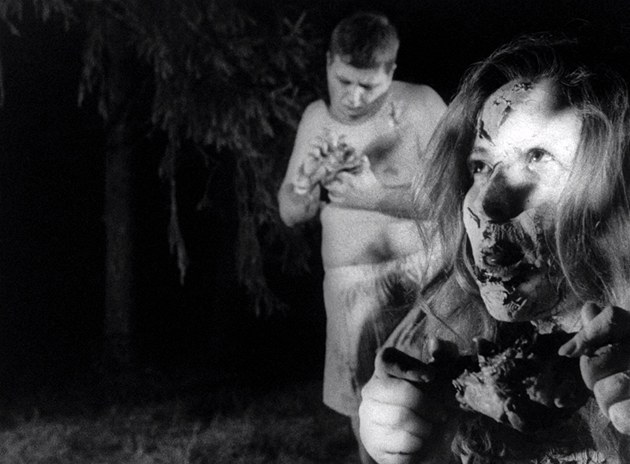 |
| Tell me truthfully that this does not terrify you... |
While the term did exist before film, it referred to something slightly different to the reanimated flesh-eating corpses we know and love, specifically a corpse placed under witchcraft to become a mindless slave of the spellcaster.
This type of zombie came from African and Haitain witchcraft culture and had little taste for human flesh but rather a taste for doing whatever the spellcaster wanted them to do, usually their laundry. This type of zombie did make several appearances in film prior to the 1960s.
 |
| To be clear, they did other things besides laundry. |
But it was in 1969 that the idea of zombie as a lumbering flesh-eating corpse was born. Created by George A. Romero, a.k.a. His High Horribleness, the Exalted God of Zombie Movies (that's his full title), in his masterpiece, Night of the Living Dead, Romero introduced the concept of having slow meandering undead corpses chase people with the sole intent of satisfying their unceasing hunger with human flesh.
 |
| Coming up in Survivor, the contestants have to face off a horde of unrelenting zombies for immunity. |
Contrary to popular belief, zombies did not go for brains initially, preferring the other other white meat (human flesh).
 |
| Zombie in the background: "I think there might be some brains in here... Gross." |
Romero pioneered the look and feel of zombie movies, from the rotting flesh of the zombies, to the unknown cause of the outbreak, to the now cliche staple of a group of survivors holed up in a house (substitute for a bunker/mall/city section, whatever) protecting themselves from the unrelenting horde of zombies outside and dealing with the unstable group dynamic they find themselves in.
 |
| He also introduced the zombie shuffle. |
Romero even developed the manner in which zombies can be seen as a metaphor for mindless consumerism through their endless and unceasing desire to consume. He took this metaphor to its most blatant extreme in Dawn of the Dead as the survivors have blockaded themselves in a mall and the zombies are effectively locked out.
Yet instead of wandering about for other people to feast on, the zombies are drawn to the mall since, as one character, Steve, reasons it is because of "Some kind of instinct. Memory of what they used to do. This was an important place in their lives."
 |
| "Wow. That shit is deep, Steve. And Francine, I wouldn't rest my chin on the barrel of a shotgun if I were you." |
Zombies now infect all media with their contagious hickies, spanning films, TV shows, games, comics and novels. However, that proliferation has meant that the zombie has lost some of its power to scare the bajesus out of people, which meant that the zombie had to be revamped in order to resonate terror in a jaded audience.
Thus, 28 Days Later introduced, or popularised, the concept of a zombie apocalypse as the result of a virus and, with the remake of Dawn of the Dead...
 |
| Running! |
Yes, running zombies were now a reality on film. Dismissed were the lumbering dead weights of old, giving way to a fitter, leaner, faster undead corpse. However, some have bemoaned the loss of the traditional zombie, and while this might smack of purist whinging, faster zombies do seem to lack the innate terror that the slow-movers incurred when a host of them managed to surround a survivor and slowly moved in...
One vocal critic of the fast zombie is Simon Pegg, who co-wrote and starred in one of the greatest zombie movies of all time, Shaun of the Dead, so his opinion has some weight. Pegg raises some good points,
"The success of the movie [28 Days Later], particularly in the US, was undoubtedly a factor in the loose remake of Romero's Dawn of the Dead in 2004. Zack Snyder's effective but pointless reboot parlayed Boyle's "infected" into the upgraded zombie 2.0, likely at the behest of some cigar-chomping, focus-group-happy movie exec desperate to satisfy the MTV generation's demand for quicker everything - quicker food, quicker downloads, quicker dead people. The zombie was ushered on to the mainstream stage, on the proviso that it sprinted up to the mic. The genre was diminished, and I think it's a shame."
But Pegg is partially to blame for a recent trend in zombie movies, for while Shaun of the Dead was a brilliant romantic comedy with zombies in it, or a romcomzom,
 |
| That's not the only wood he's packing. Ladies. |
This has given rise to the romance zombie movie.
| No, seriously, he is a zombie. I know, he doesn't have rotting flesh but... |
Whilst, at the moment this is still at the acceptable stage- by all accounts the Warm Bodies film is supposed to be quite enjoyable (I haven't seen it and cannot comment) and I liked the book despite its 'love will conquer all' deus ex machina ending- it won't be long before zombies go the way of the vampire and are hit with some sort of vomit-educing low like Twilight that completely and utterly ruins them as monsters, a blow from which they may never recover.
 |
| Unless stuff like this continues to be made. |
Links:
Simon Pegg article-
http://www.guardian.co.uk/media/2008/nov/04/television-simon-pegg-dead-set
No comments:
Post a Comment